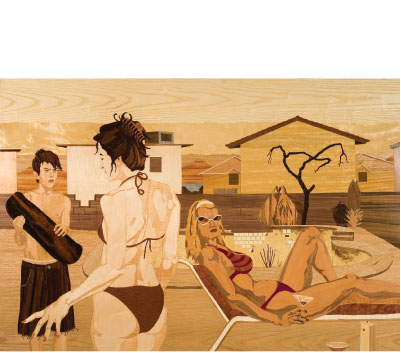
“It’s a tradition to escape by going West,” says Alison Elizabeth Taylor, referring to the wide-open spaces that beckon America’s freedom seekers. Since Taylor went the opposite direction, from Los Angeles to New York City, to attend Columbia University’s MFA program in 2003, her artwork has been intensely preoccupied with the West she left behind. “I grew up hating the desert,” she says about her years in Las Vegas. “I thought it was so oppressive. I felt like it made everything in the real world so much farther away from me, but I don’t feel that way now.”
Taylor’s work tells stories about individuals who have struck a bargain with the desert — freedom for isolation, she calls it — and gladly agree to its terms. In her latest series, she pays homage to this American brand of misfit, using a technique called marquetry, or wood inlay, that employs different grains of wood sanded down to a regal sheen. Against an arid, barren backdrop of varying shades of brown, the inevitable collision between Utopia and reality plays out. In Taylor’s art, big-box stores and subdivisions multiply exponentially, and dirt roads turn into four-lane highways — all signs of society’s unrelenting encroachment. As she does in all of her work, Taylor peels back the clean, shiny surface of the American Dream to give us a glimpse of the alienation, boredom, and violence that exist just underneath. Whether her subject matter involves a drunken confrontation, an accidental drowning, or a man on the run, she offers us just a hint of the narrative and lets our imaginations do the rest.




 Facebook
Facebook Permalink
Permalink Digg
Digg Reddit
Reddit LinkedIn
LinkedIn StumbleUpon
StumbleUpon Tumblr
Tumblr

